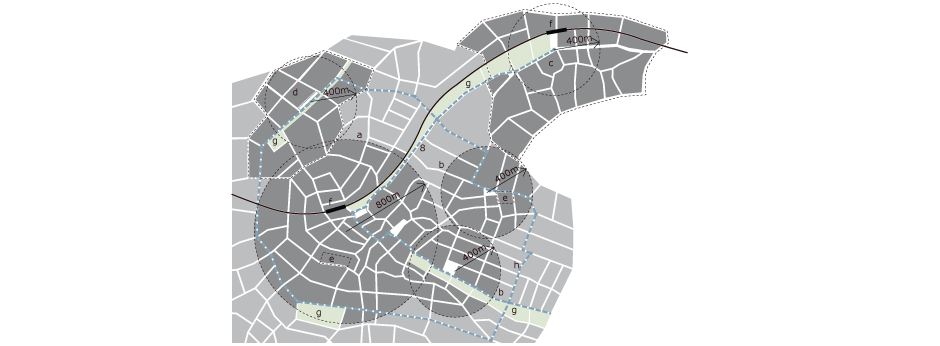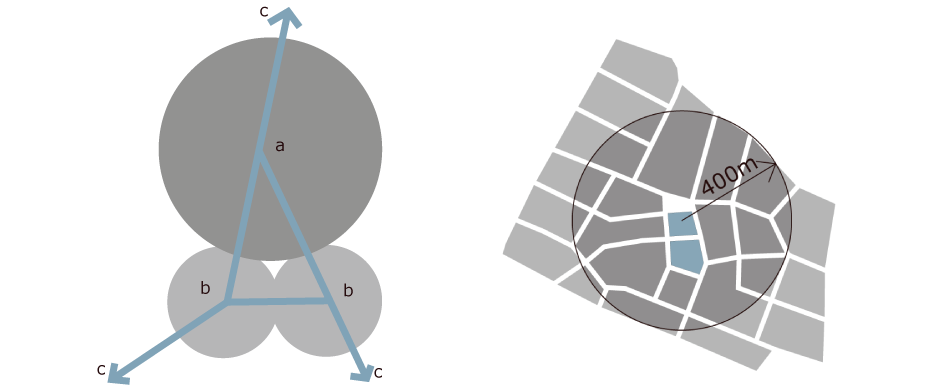Spatial
The spatial context of a site is defined by its location within the area as a whole. Urban areas are invariably most compact, intensive and tall at their centres, which is usually a consequence of land value determining economy and diversity in the deployment of space. Older centres tend to be more diverse and newer centres, less so. Both will contain shops, employment and services in addition to a transport interchange (at least within larger towns).
The outward spread of urban areas (particularly those parts developed since the 18th century has created neighbourhoods with a local centre that usually coincides with a road junction or other transport interchange. While these neighbourhoods are less compact, intensive and tall than the urban centre, they nevertheless possess such qualities relative to their immediate surroundings. As such, they often contain shops serving local needs, some workspace and community buildings. It is therefore in these urban and neighbourhood centres that development should be most dense and diverse, reinforcing their economic and symbolic importance.
The traditional neighbourhood is almost always laid out on the basis of convenient pedestrian access, the edge of the neighbourhood rarely being more than five minutes’ walk away. Typically, neighbourhoods link up along established transport corridors to form a chain of development that increases in density towards the centre of each neighbourhood. Preserving and reinforcing this hierarchy of density is fundamental to achieving a sustainable urban form.
Occasionally, a development site is of sufficient size for it to accommodate a new, sustainable community, such as a garden suburb. Generally speaking, 50 hectares is required for such a development, which equates to the same five-minute ‘walkable neighbourhood’ model described above.
Such a development would ideally have a compact mixed-use centre and progressively lower commercial and residential densities towards the extremity of the site. This kind of arrangement is suitable for:
- a large infill site within an existing urban area;
- a sustainable urban extension attached to the existing boundary of a settlement; or
- a regeneration area where a substantial tract of redundant or poor-quality land is to be transformed.
New high-density developments outside town centres or neighbourhoods (either existing or new) are likely to appear out of context with their surroundings. They are also less likely to prove sustainable in use than developments that are closer to services and public transport provision. Within the hinterland, there will be a presumption against high-density development with an assumption that matches the scale and density of developments to their immediate surroundings.
In this guide, locations suitable for higher density, sustainable development have been identified as:
- Urban Centres
- Neighbourhoods
- Large Urban Infill
- Sustainable Urban Extensions
The context and nature of these locations, whether already developed or substantially vacant and available for development, is highly relevant to the Context Appraisal process. Such factors help to determine whether existing features must be preserved and reinforced or else changed.
Existing urban places in Essex may generally be categorised as follows:
Existing Large Urban Centres:
- Serve a town with a population greater than 35,000
- Have a public transport interchange
- Have a walkable radius of 800m (10 mins)
- Have a good range of shops
- Have a good range of services
- Offer a good range of employment opportunities
- Building heights occasionally greater than four storeys
Existing Small Urban Centres:
- Serve a population between 10,000 and 35,000
- Close to local bus services (15 minutes or less in each direction)
- Have a walkable radius of 400m (five minutes)
- Have a range of shops
- Have a range of services
- Offer a range of employment opportunities
- Building heights occasionally greater than three storeys
Existing Neighbourhoods:
- Located in a town served by either a large or a small urban centre as defined above
- Close to frequent local bus services with bus stops within walking distance (400m, five minutes)
- Have walkable radius of 400m (five minutes)
- Have a range of shops
- Have a range of services
- Offer a range of employment opportunities
- Building heights occasionally greater than three storeys
Sites for Sustainable Urban Extensions:
- Minimum 50 hectares in extent
- Greenfield and occasionally brownfield land
- Adjacent to an existing urban edge
- Lack of urban character
- Landscape-dominant
- Poorly served by public transport
- Remote from urban facilities
- Inaccessible/remote
An urban extension of 50ha could contain around 2000 homes, green space and community uses plus 100,000 sq m of commercial space – all within a built fabric of no higher than four storeys.
Sites for Garden Communities:
- Minimum 50 hectares in extent
- Greenfield and occasionally brownfield land
- Adjacent to an existing urban edge
- Landscape-dominant
- Suitable to be access via public transport
- Remote from urban facilities
Sites for Large Urban Infill:
- Minimum 50 hectares in extent
- Surrounding built context, existing urban character
- Probably brownfield land of redundant institutional or industrial use
- Probably biologically diverse
- Existing buildings on site; potential for re-use
- Few urban facilities
- Reasonably close to urban transport routes
Sites for Small Urban Infill:
- Strong built context and existing urban character
- Clear site constraints
- Probably brownfield or redundant land

a. urban centre b. neighbourhoods/small urban centrep c. sustainable urban extension d. large urban infill e. small urban infill f. railway station g. green space h. bus route
At the start of the Context Appraisal process, it is important to agree the appropriate spatial context of the site in writing with the local planning authority. This is important in establishing the likely minimum density and development characteristics.
Page updated: 5/02/2018
